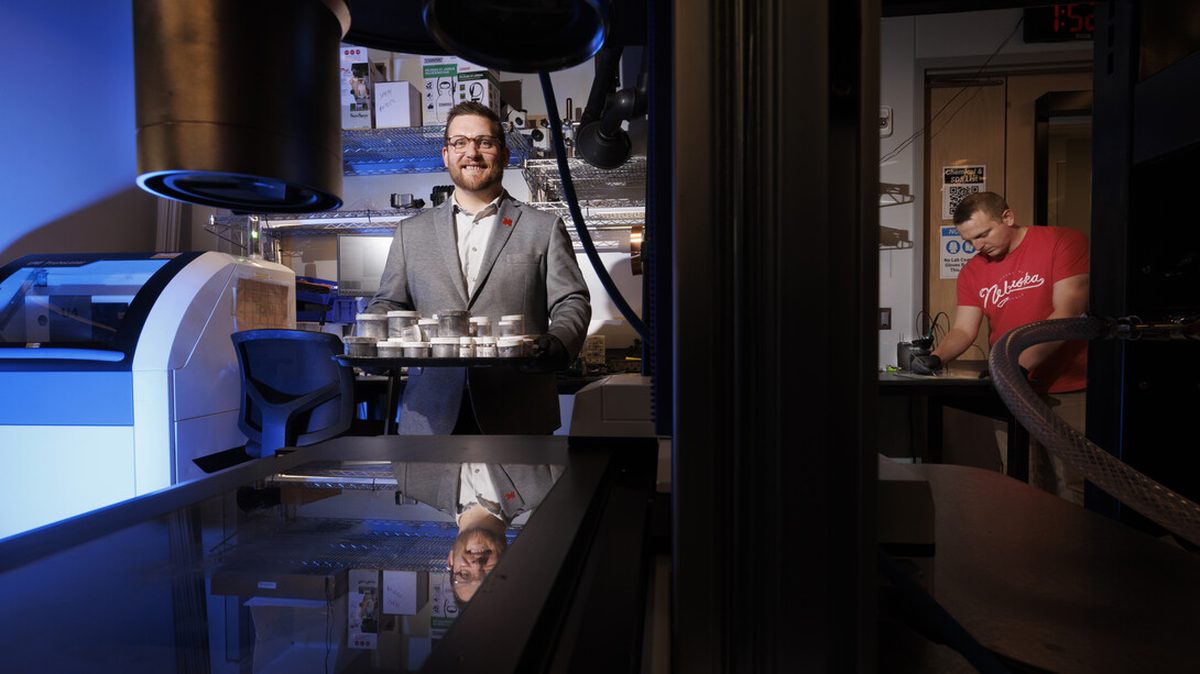Self-healing robot skin mimics the human body

A University of Nebraska–Lincoln engineering team, led by Eric Markvicka and graduate students Ethan Krings and Patrick McManigal, presented self-healing technology for soft robotics and wearable systems at the IEEE International Conference on Robotics and Automation.
Award-winning research in biomimicryTheir paper outlined a systems-level approach for soft robotics to identify damage, locate it, and autonomously initiate self-repair. The paper was among 39 of 1,606 submissions selected as an ICRA 2025 Best Paper Award finalist. It also received finalist recognition for the Best Student Paper Award and in the mechanism and design category. Markvicka, the Robert F. and Myrna L. Krohn Assistant Professor of Biomedical Engineering, noted that the community is pushing to replicate traditional rigid systems using soft materials and embrace biomimicry.
“While we’ve been able to create stretchable electronics and actuators that are soft and conformal, they often don’t mimic biology in their ability to respond to damage and then initiate self-repair.”
The team developed an intelligent, self-healing artificial muscle with a multi-layer architecture. This architecture enables the system to identify and locate damage, then initiate a self-repair mechanism without external intervention.
“The human body and animals are amazing. We can get cut and bruised and get some pretty serious injuries. And in most cases, with very limited external applications of bandages and medications, we’re able to self-heal a lot of things. If we could replicate that within synthetic systems, that would really transform the field and how we think about electronics and machines.”
A three-layered approachThe artificial muscle, or actuator, features three distinct layers. The bottom layer serves as the damage detection component, consisting of a soft electronic skin formed from liquid metal microdroplets embedded within a silicone elastomer. Adhered to this bottom layer is the middle component, which functions as the self-healing element; it is a stiff thermoplastic elastomer. The topmost layer is the actuation layer, designed to initiate the muscle’s motion when pressurized with water.
The healing processThe operational process begins with the team inducing five monitoring currents across the artificial muscle’s bottom “skin,” which is connected to a microcontroller and sensing circuit. Damage, such as a puncture or extreme pressure to this layer, triggers the formation of an electrical network between the monitoring traces. The system recognizes this unique electrical footprint as definitive evidence of damage. Subsequently, the system increases the current flowing through this newly formed electrical network.
This increased current causes the network to function as a localized Joule heater, converting the electrical current’s energy into heat specifically around the damaged areas. After a period of a few minutes, this localized heat melts and reprocesses the middle thermoplastic layer, effectively sealing the damage and completing the self-healing process.
The final step involves resetting the system to its original state by erasing the electrical footprint of damage in the bottom layer. To achieve this, Markvicka’s team leverages the effects of electromigration, a process where an electrical current causes metal atoms to migrate. Traditionally, electromigration is viewed as a detrimental phenomenon in metallic circuits because the movement of atoms deforms materials and creates gaps, leading to device failure.
This AI model finds low-emission cement in milliseconds
The researchers innovatively utilize electromigration to solve a long-standing challenge in autonomous self-healing systems: the perceived permanence of damage-induced electrical networks in the bottom layer. Without the ability to reset the baseline monitoring traces, the system could not complete more than one cycle of damage and repair.
Markvicka explained that electromigration, with its capacity to physically separate metal ions and induce open-circuit failure, presented a solution for erasing these newly formed traces. The strategy proved effective: by further increasing the current, the team can induce electromigration and thermal failure mechanisms that reset the damage detection network.
“Electromigration is generally seen as a huge negative. It’s one of the bottlenecks that has prevented the miniaturization of electronics. We use it in a unique and really positive way here. Instead of trying to prevent it from happening, we are, for the first time, harnessing it to erase traces that we used to think were permanent.”
This autonomously self-healing technology has potential applications across various industries. In agricultural states, it could significantly benefit robotic systems frequently exposed to sharp objects like twigs, thorns, plastic, and glass. It also offers advantages for wearable health monitoring devices, enhancing their durability against daily wear and tear. Furthermore, this technology holds broader societal benefits. Most consumer electronics have short lifespans, typically one to two years, contributing to billions of pounds of electronic waste annually. This waste contains hazardous toxins such as lead and mercury, posing threats to both human and environmental health. Self-healing technology offers a method to mitigate this issue.
“If we can begin to create materials that are able to passably and autonomously detect when damage has happened, and then initiate these self-repair mechanisms, it would really be transformative.”
The National Science Foundation, NASA Nebraska Established Program to Stimulate Competitive Research, and the Nebraska Tobacco Settlement Biomedical Research Development Fund supported this research.
